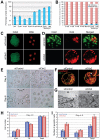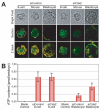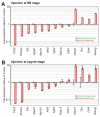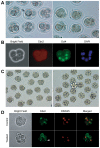Initiation of trophectoderm lineage specification in mouse embryos is independent of Cdx2
- PMID: 21098565
- PMCID: PMC2990207
- DOI: 10.1242/dev.056630
Initiation of trophectoderm lineage specification in mouse embryos is independent of Cdx2
Abstract
The separation of the first two lineages - trophectoderm (TE) and inner cell mass (ICM) - is a crucial event in the development of the early embryo. The ICM, which constitutes the pluripotent founder cell population, develops into the embryo proper, whereas the TE, which comprises the surrounding outer layer, supports the development of the ICM before and after implantation. Cdx2, the first transcription factor expressed specifically in the developing TE, is crucial for the differentiation of cells into the TE, as lack of zygotic Cdx2 expression leads to a failure of embryos to hatch and implant into the uterus. However, speculation exists as to whether maternal Cdx2 is required for initiation of TE lineage separation. Here, we show that effective elimination of both maternal and zygotic Cdx2 transcripts by an RNA interference approach resulted in failure of embryo hatching and implantation, but the developing blastocysts exhibited normal gross morphology, indicating that TE differentiation had been initiated. Expression of keratin 8, a marker for differentiated TE, further confirmed the identity of the TE lineage in Cdx2-deficient embryos. However, these embryos exhibited low mitochondrial activity and abnormal ultrastructure, indicating that Cdx2 plays a key role in the regulation of TE function. Furthermore, we found that embryonic compaction does not act as a 'switch' regulator to turn on Cdx2 expression. Our results clearly demonstrate that neither maternal nor zygotic Cdx2 transcripts direct the initiation of ICM/TE lineage separation.
Figures







Similar articles
-
TEAD4 regulates trophectoderm differentiation upstream of CDX2 in a GATA3-independent manner in the human preimplantation embryo.Hum Reprod. 2022 Jul 30;37(8):1760-1773. doi: 10.1093/humrep/deac138. Hum Reprod. 2022. PMID: 35700449
-
Lineage segregation in human pre-implantation embryos is specified by YAP1 and TEAD1.Hum Reprod. 2023 Aug 1;38(8):1484-1498. doi: 10.1093/humrep/dead107. Hum Reprod. 2023. PMID: 37295962
-
Sox2 is essential for formation of trophectoderm in the preimplantation embryo.PLoS One. 2010 Nov 12;5(11):e13952. doi: 10.1371/journal.pone.0013952. PLoS One. 2010. PMID: 21103067 Free PMC article.
-
Trophoblast lineage specification in the mammalian preimplantation embryo.Reprod Med Biol. 2020 Jul 2;19(3):209-221. doi: 10.1002/rmb2.12333. eCollection 2020 Jul. Reprod Med Biol. 2020. PMID: 32684820 Free PMC article. Review.
-
Mechanisms of trophectoderm fate specification in preimplantation mouse development.Dev Growth Differ. 2010 Apr;52(3):263-73. doi: 10.1111/j.1440-169X.2009.01158.x. Epub 2010 Jan 20. Dev Growth Differ. 2010. PMID: 20100249 Review.
Cited by
-
Extracellular vesicles improve embryo cryotolerance by maintaining the tight junction integrity during blastocoel re-expansion.Reproduction. 2022 Feb 24;163(4):219-232. doi: 10.1530/REP-21-0320. Reproduction. 2022. PMID: 35129460 Free PMC article.
-
Nuclear receptor-SINE B1 network modulates expanded pluripotency in blastoids and blastocysts.Nat Commun. 2024 Nov 19;15(1):10011. doi: 10.1038/s41467-024-54381-0. Nat Commun. 2024. PMID: 39562549 Free PMC article.
-
Nested information processing in the living world.Ann N Y Acad Sci. 2021 Sep;1500(1):5-16. doi: 10.1111/nyas.14612. Epub 2021 May 26. Ann N Y Acad Sci. 2021. PMID: 34042190 Free PMC article. Review.
-
Evidence that transcription factor AP-2γ is not required for Oct4 repression in mouse blastocysts.PLoS One. 2013 May 31;8(5):e65771. doi: 10.1371/journal.pone.0065771. Print 2013. PLoS One. 2013. PMID: 23741512 Free PMC article.
-
Maternal Cdx2 is dispensable for mouse development.Development. 2012 Nov;139(21):3969-72. doi: 10.1242/dev.086025. Epub 2012 Sep 19. Development. 2012. PMID: 22992952 Free PMC article.
References
-
- Bai Y. Q., Yamamoto H., Akiyama Y., Tanaka H., Takizawa T., Koike M., Kenji Yagi O., Saitoh K., Takeshita K., Iwai T., et al. (2002). Ectopic expression of homeodomain protein CDX2 in intestinal metaplasia and carcinomas of the stomach. Cancer Lett. 176, 47-55 - PubMed
-
- Boiani M., Gambles V., Schöler H. R. (2004). ATP levels in clone mouse embryos. Cytogenet. Genome Res. 105, 270-278
-
- Boiani M., Gentile L., Gambles V. V., Cavaleri F., Redi C. A., Scholer H. R. (2005). Variable reprogramming of the pluripotent stem cell marker Oct4 in mouse clones: distinct developmental potentials in different culture environments. Stem Cells 23, 1089-1104 - PubMed
Publication types
MeSH terms
Substances
Grants and funding
LinkOut - more resources
Full Text Sources
Molecular Biology Databases
Research Materials

